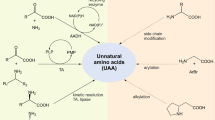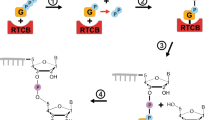Abstract
Spermidine synthase catalyzes the production of spermidine from putrescine and decarboxylated S-adenosylmethionine (dcSAM), and plays a crucial role in cell proliferation and differentiation. The gatekeeping loop identified in the structure of spermidine synthase was predicted to contain residues important for substrate binding, but its correlation with enzyme catalysis has not been fully understood. In this study, recombinant Escherichia coli spermidine synthase (EcSPDS) was produced and its enzyme kinetics was characterized. Site-directed mutants of EcSPDS were obtained to demonstrate the importance of the amino acid residues in the gatekeeping loop. Substitution of Asp158 and Asp161 with alanine completely abolished EcSPDS activity, suggesting that these residues are absolutely required for substrate interaction. Reduction in enzyme activity was observed in the C159A, T160A, and P165Q variants, indicating that hydrophobic interactions contributed by Cys159, Thr160, and Pro165 are important for enzyme catalysis as well. On the other hand, replacement of Pro162 and Ile163 had no influence on EcSDPS activity. These results indicate that residues in the gatekeeping loop of spermidine synthase are indispensable for the catalytic reaction of EcSPDS. To the best of our knowledge, this is the first functional study on the gatekeeping loop of EcSPDS by site-directed mutagenesis.








Similar content being viewed by others
References
Igarashi, K., & Kashiwagi, K. (2000). Polyamines: mysterious modulators of cellular functions. Biochemical and Biophysical Research Communications, 271, 559–564.
Tabor, C. W., & Tabor, H. (1984). Polyamines. Annual Review of Biochemistry, 53, 749–790.
Pegg, A. E. (1986). Recent advances in the biochemistry of polyamines in eukaryotes. Biochemistry Journal, 234, 249–262.
Michael, A. J. (1999). Genes of polyamine synthesis and transport: Exploiting genome projects to determine similarities and differences between plant, microbial and animal polyamine metabolic pathways. In S. Bardocz & A. White (Eds.), Polyamines in health and nutrition (pp. 55–64). Boston: Kluwer Academic.
Yoon, S. O., Lee, Y. S., Lee, S. H., & Cho, Y. D. (2000). Polyamine synthesis in plants: isolation and characterization of spermidine synthase from soybean (Glycine max) axes. Biochimica et Biophysica Acta, 1475, 17–26.
Haider, N., Eschbach, M. L., Dias Sde, S., et al. (2005). The spermidine synthase of the malaria parasite Plasmodium falciparum: molecular and biochemical characterisation of the polyamine synthesis enzyme. Molecular and Biochemical Parasitology, 142, 224–236.
Wu, H., Min, J., Ikeguchi, Y., et al. (2007). Structure and mechanism of spermidine synthases. Biochemistry, 46, 8331–8339.
Zappia, V., Cacciapuoti, G., Pontoni, G., & Oliva, A. (1980). Mechanism of propylamine-transfer reactions. Kinetic and inhibition studies on spermidine synthase from Escherichia coli. Journal of Biological Chemistry, 255, 7276–7280.
Bowman, W. H., Tabor, C. W., & Tabor, H. (1973). Spermidine biosynthesis. Purification and properties of propylamine transferase from Escherichia coli. Journal of Biological Chemistry, 248, 2480–2486.
Tabor, C. W., Tabor, H., & Xie, Q. W. (1986). Spermidine synthase of Escherichia coli: localization of the speE gene. Proc Natl Acad Sci USA, 83, 6040–6044.
Tabor, C. W., Tabor, H., & Hafner, E. W. (1978). Escherichia coli mutants completely deficient in adenosylmethionine decarboxylase and in spermidine biosynthesis. Journal of Biological Chemistry, 253, 3671–3676.
Chattopadhyay, M. K., Tabor, C. W., & Tabor, H. (2009). Polyamines are not required for aerobic growth of Escherichia coli: preparation of a strain with deletions in all of the genes for polyamine biosynthesis. Journal of Bacteriology, 191, 5549–5552.
Hamasaki-Katagiri, N., Tabor, C. W., & Tabor, H. (1997). Spermidine biosynthesis in Saccharomyces cerevisae: polyamine requirement of a null mutant of the SPE3 gene (spermidine synthase). Gene, 187, 35–43.
Pitkin, J., & Davis, R. H. (1990). The genetics of polyamine synthesis in Neurospora crassa. Archives of Biochemistry and Biophysics, 278, 386–391.
Zhou, X., Chua, T. K., Tkaczuk, K. L., et al. (2010). The crystal structure of Escherichia coli spermidine synthase SpeE reveals a unique substrate-binding pocket. Journal of Structural Biology, 169, 277–285.
Korolev, S., Ikeguchi, Y., Skarina, T., et al. (2002). The crystal structure of spermidine synthase with a multisubstrate adduct inhibitor. Natural Structural Biology, 9, 27–31.
Samejima, K., Nakazawa, Y., & Matsunaga, I. (1978). Improved synthesis of decarboxylated S-adenosylmethionine and related sulfonium compounds. Chemical & Pharmaceutical Bulletin, 26, 1480–1485.
Dejima, H., Kobayashi, M., Takasaki, H., et al. (2003). Synthetic decarboxylated S-adenosyl-l-methionine as a substrate for aminopropyl transferases. Biological &/and Pharmaceutical Bulletin, 26, 1005–1008.
Lee, M. J., Huang, C. Y., Sun, Y. J., & Huang, H. (2005). Cloning and characterization of spermidine synthase and its implication in polyamine biosynthesis in Helicobacter pylori strain 26695. Protein Expression and Purification, 43, 140–148.
Bradford, M. M. (1976). A rapid and sensitive method for the quantitation of microgram quantities of protein utilizing the principle of protein-dye binding. Analytical Biochemistry, 72, 248–254.
Lee, M. J., Huang, H., Lin, W., et al. (2007). Activation of Helicobacter pylori inorganic pyrophosphatase and the importance of Cys16 in thermostability, enzyme activation and quaternary structure. Archives of Microbiology, 188, 473–482.
Redmond, J. W., & Tseng, A. (1979). High-pressure liquid chromatographic determination of putrescine, cadaverine, spermidine and spermine. Journal of Chromatography, 170, 479–481.
Morgan, D. M. (1998). Determination of polyamines as their benzoylated derivatives by HPLC. Methods in Molecular Biology, 79, 111–118.
Shirahata, A., Takeda, Y., Kawase, M., & Samejima, K. (1983). Detection of spermine and thermospermine by thin-layer chromatography. Journal of Chromatography, 262, 451–454.
Samejima, K., Dairman, W., & Udenfriend, S. (1971). Condensation of ninhydrin with aldehydes and primary amines to yield highly fluorescent ternary products. I. Studies on the mechanism of the reaction and some characteristics of the condensation product. Analytical Biochemistry, 42, 222–236.
Samejima, K., Dairman, W., Stone, J., & Udenfriend, S. (1971). Condensation of ninhydrin with aldehydes and primary amines to yield highly fluorescent ternary products. II. Application to the detection and assay of peptides, amino acids, amines, and amino sugars. Analytical Biochemistry, 42, 237–247.
Lee, M. J., Liu, C. H., Wang, S. Y., et al. (2006). Characterization of the Soj/Spo0J chromosome segregation proteins and identification of putative parS sequences in Helicobacter pylori. Biochemical and Biophysical Research Communications, 342, 744–750.
Samejima, K., & Yamanoha, B. (1982). Purification of spermidine synthase from rat ventral prostate by affinity chromatography on immobilized S-adenosyl(5′)-3-thiopropylamine. Archives of Biochemistry and Biophysics, 216, 213–222.
Burger, P. B., Birkholtz, L. M., Joubert, F., et al. (2007). Structural and mechanistic insights into the action of Plasmodium falciparum spermidine synthase. Bioorganic & Medicinal Chemistry, 15, 1628–1637.
Arnold, K., Bordoli, L., Kopp, J., & Schwede, T. (2006). The SWISS-MODEL workspace: a web-based environment for protein structure homology modelling. Bioinformatics, 22, 195–201.
Acknowledgments
We thank Dr. K. Samejima, Faculty of Pharmaceutical Sciences, Josai University, Saitama, Japan, for generously providing dcSAM. This research was supported by the National Research Program for Genomic Medicine, National Science Council, Taiwan (NSC93-3112-B-007-016 and NSC92-3112-B-007-015).
Author information
Authors and Affiliations
Corresponding author
Rights and permissions
About this article
Cite this article
Lee, MJ., Yang, YT., Lin, V. et al. Site-Directed Mutations of the Gatekeeping Loop Region Affect the Activity of Escherichia coli Spermidine Synthase. Mol Biotechnol 54, 572–580 (2013). https://doi.org/10.1007/s12033-012-9599-3
Published:
Issue Date:
DOI: https://doi.org/10.1007/s12033-012-9599-3




